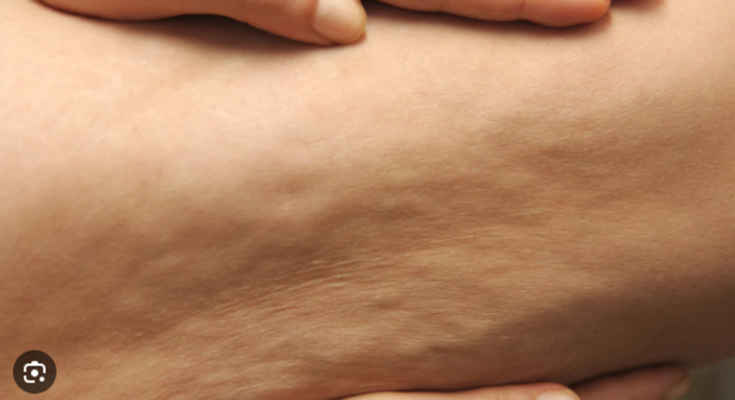Cellulite Treatment: Cellulite, often described as a ‘cottage cheese’ or ‘orange peel’ texture of the skin, is a common, yet misunderstood condition affecting millions of individuals worldwide, regardless of their body type or weight.
This condition is more prevalent in women than in men due to differences in fat distribution, muscle, and connective tissue structure.
Understanding the diagnosis and treatment options available is crucial in managing this cosmetic concern effectively.
What is Cellulite?
Cellulite is a common, non-harmful skin condition that creates a dimpled, lumpy appearance on the skin, most frequently observed on thighs, buttocks, hips, and abdomen. It results from fat deposits pushing through the connective tissue beneath the skin. Despite being entirely normal and affecting up to 90% of women at some point in their lives, cellulite can be a source of cosmetic concern for many.
Causes of Cellulite
The exact cause of cellulite is not fully understood, but it’s believed to be influenced by a combination of factors:
- Hormonal Factors: Hormones such as estrogen, insulin, and thyroid hormones are thought to play a role in cellulite development.
- Genetics: Family history may determine your predisposition to cellulite, including your skin structure, texture, and body type.
- Diet and Lifestyle: Although cellulite affects individuals of all sizes, excessive fat accumulation can make cellulite more visible. Lack of exercise, a diet high in fats, carbohydrates, and salt, which can increase fat storage and fluid retention, may contribute to its appearance.
- Age: Skin loses elasticity with age, which can make cellulite more apparent.
- Tissue Structure: Differences in connective tissue structure between genders may explain why cellulite is more prevalent in women.
Myths vs. Facts: Debunking Common Misconceptions about Cellulite
Myth 1: Cellulite Only Affects Overweight People
Fact: Cellulite can affect individuals of all body types and weights. While excess body fat can make cellulite more noticeable, even very lean people can have it.
Myth 2: Only Women Get Cellulite
Fact: Although cellulite is more common in women due to the differences in fat distribution, connective tissue, and hormonal factors, men can also develop cellulite.
Myth 3: Extreme Dieting and Exercise Can Eliminate Cellulite
Fact: While a healthy diet and regular exercise can reduce the appearance of cellulite by lowering fat levels and improving muscle tone, they may not completely eliminate it. Genetics plays a significant role in its presence.
Myth 4: Cellulite is Harmful
Fact: Cellulite is a purely cosmetic issue and does not pose any health risks. It’s a normal condition that does not require medical treatment.
Understanding the nature of cellulite and distinguishing facts from myths is crucial in promoting a healthy body image and self-acceptance. While numerous treatments and products claim to remove cellulite, it’s important to approach them with realistic expectations and understand that cellulite is a normal, widespread condition.
Signs and Symptoms of Cellulite
Understanding the signs and symptoms of cellulite is crucial for identification and management. Here, we explore the symptoms, appearance, common areas affected, and the stages of cellulite development.
List of Symptoms of Cellulite
- Dimpled or Lumpy Skin: The most apparent symptom of cellulite is the uneven, dimpled surface of the skin, resembling cottage cheese or an orange peel.
- Skin Texture Changes: The affected areas may feel more spongy or firmer to the touch than surrounding skin.
- Tenderness: Some individuals might experience tenderness or slight pain when the affected area is pressed.
How to Identify Cellulite: Appearance and Common Areas Affected
Cellulite is identifiable by its unique appearance – a dimpled or lumpy texture on the skin’s surface. It commonly appears in areas with underlying fat deposits, including:
- Thighs: The most frequent area for cellulite to occur due to the natural fat distribution in the legs.
- Buttocks: Another common site for cellulite, affecting the appearance and feel of the skin.
- Abdomen: Cellulite can develop here, especially in women post-pregnancy or individuals with significant weight fluctuations.
- Arms: Upper arms are less commonly affected but can still exhibit signs of cellulite, particularly in older individuals or those with significant weight loss.
The Stages of Cellulite Development
Understanding the stages of cellulite can help in identifying the condition early and managing it effectively:
- Stage 1: At this initial stage, cellulite is not visible to the naked eye. It may only be detected under a microscope where underlying anatomical changes start.
- Stage 2: The skin’s surface remains smooth when standing, but dimples appear when sitting or pinching the skin.
- Stage 3: Dimples are visible on the skin’s surface while standing, indicating more advanced cellulite.
- Stage 4: The cellulite is highly visible, with deep and pronounced dimples. The skin may also exhibit significant textural changes and elasticity loss.
Identifying cellulite in its early stages is beneficial for managing its appearance through lifestyle changes, medical treatments, or dermatological procedures. Regular exercise, maintaining a healthy weight, and proper skincare can help reduce the visibility of cellulite. If cosmetic concerns arise, consulting with a healthcare provider or dermatologist can provide options tailored to individual needs and conditions.
Professional Diagnosis of Cellulite
Cellulite, often characterized by dimpled or lumpy skin appearance, is a common concern affecting many individuals, particularly women. While it’s primarily a cosmetic issue, understanding when to seek professional advice and the diagnostic methods used can be crucial for your peace of mind and health.
When to Consult a Healthcare Professional for Cellulite
It’s advisable to consult with a healthcare professional if:
- Your cellulite is painful: If the areas with cellulite are tender or cause discomfort, it’s important to get a professional evaluation to rule out any underlying conditions.
- Rapid appearance or worsening: Sudden onset or quick worsening of cellulite could be indicative of underlying health issues.
- Concerns about appearance: For those who are concerned about the aesthetic aspect of cellulite and how it affects their self-esteem or daily life, a professional can provide advice on effective treatment options.
Seeking advice from a healthcare provider can not only offer peace of mind but also ensure that the cellulite isn’t a symptom of another health issue.
Diagnostic Methods Used by Professionals
Healthcare professionals utilize various diagnostic methods to assess and diagnose cellulite, including:
- Visual Examination: The most common method is a straightforward visual examination where the doctor assesses the skin’s appearance in areas typically affected by cellulite, such as thighs, buttocks, and abdomen.
- Pinch Test: Also known as the “orange peel” test, this involves pinching the skin in the affected area to observe the dimpling effect of cellulite.
- Grade Scale Assessment: Professionals may use a grade scale to classify the severity of cellulite. This scale typically ranges from 0 to 3, with 0 indicating no cellulite and 3 signifying severe cellulite with deep depressions and a rugged skin appearance.
- Ultrasound: In some cases, an ultrasound may be used to examine the structure of the skin and fat layers to understand the extent of cellulite better.
- Bioelectrical Impedance Analysis (BIA): Though less common, BIA can be used to measure the composition of body fat and lean muscle, which may provide insights into factors contributing to cellulite.
Consulting with a healthcare professional can provide a comprehensive understanding of your cellulite’s severity and the most appropriate treatment options. Remember, while cellulite is a common and often harmless condition, getting a professional diagnosis is vital to addressing any potential underlying health concerns and exploring treatment paths tailored to your individual needs.
Comprehensive Guide to Cellulite Treatment Options
This comprehensive guide delves into the myriad of cellulite treatment methods, focusing on their effectiveness and safety, to help you make informed decisions.
Non-Invasive Treatments
Non-invasive treatments for cellulite are popular due to their minimal to no downtime and lower risk profiles. These include:
- Topical Treatments: A wide range of creams and serums claim to reduce cellulite’s appearance. These products often contain caffeine, retinol, or antioxidants, which are believed to improve skin elasticity and decrease fat cells. While easy to use and generally safe, their effectiveness varies, and results may be subtle.
- Massage Techniques and Mechanical Suction Devices: Manual massages and devices that use suction aim to stimulate lymphatic drainage and improve circulation, potentially reducing cellulite’s appearance. Regular sessions might offer temporary skin smoothing benefits, though scientific evidence supporting long-term effectiveness is limited.
- Laser Therapy and Radiofrequency Treatments: These advanced options use heat, sound waves, or light to break down fat cells and stimulate collagen production, aiming to improve skin texture and elasticity. Laser therapy and radiofrequency treatments have shown promising results in reducing cellulite, with effects lasting for months. However, multiple sessions are often required, and costs can be high.
Minimally Invasive Treatments
For those seeking more pronounced results, minimally invasive treatments offer an alternative:
- Subcision: This procedure involves a specialized needle being inserted under the skin to break up the fibrous bands causing cellulite dimples. The results can be long-lasting, but the procedure may cause bruising and require a short recovery period.
- Laser-Assisted Liposuction: Although not a primary treatment for cellulite, laser-assisted liposuction can reduce fat and improve contour. However, it’s essential to have realistic expectations, as it might not affect the skin’s surface texture.
- Injectable Treatments: Recent advancements include injectables designed to break down the fibrous bands beneath the skin. These treatments can offer a temporary reduction in cellulite appearance but may require ongoing sessions to maintain results.
Lifestyle and Home Remedies
In addition to medical treatments, certain lifestyle changes and home remedies can complement efforts to reduce cellulite:
- Diet and Hydration: A balanced diet rich in fruits, vegetables, and healthy fats can support skin health. Staying hydrated helps maintain the skin’s elasticity and can minimize cellulite’s appearance.
- Exercise Routines: Regular physical activity, especially strength training and aerobic exercises, can reduce fat, improve muscle tone, and diminish the appearance of cellulite over time.
- Regular Massage and Skin Care: Consistent massage and proper skin care, including exfoliation and moisturizing, can enhance circulation and skin texture, potentially reducing the visibility of cellulite.
Choosing the right cellulite treatment depends on individual goals, budget, and tolerance for potential side effects. It’s essential to consult with a healthcare professional or a dermatologist to discuss the most suitable options based on your specific needs and medical history. With realistic expectations and a comprehensive approach, managing cellulite can be a more attainable goal.
Choosing the Right Cellulite Treatment
In this guide, we’ll delve into how to choose the right cellulite treatment for you, focusing on the importance of skin type, cellulite stage, and the invaluable role of dermatologists or skin care professionals in this journey.
Factors to Consider When Selecting a Treatment
1. Skin Type: Your skin type is a pivotal factor in determining the most suitable cellulite treatment. Different skin types react differently to treatments. For instance, sensitive skin may not tolerate certain topical treatments well, whereas thicker skin might need more intensive therapies. Knowing your skin type can help you avoid treatments that may cause irritation or adverse reactions.
2. Cellulite Stage: Cellulite progresses through several stages, from mild dimpling when the skin is pinched, to more visible and permanent dimpling. The effectiveness of treatments can vary significantly depending on the stage of cellulite. Early-stage cellulite might respond well to topical treatments and lifestyle changes, whereas more advanced stages may require laser therapy or radiofrequency treatments.
3. Personal Health and Medical History: Your overall health and medical history can influence the choice of cellulite treatment. Certain medical conditions or medications can affect your treatment options and outcomes. It’s essential to consider these factors to ensure the chosen treatment is safe and suitable for your health status.
4. Treatment Efficacy and Evidence: Research and evidence supporting the efficacy of a cellulite treatment should not be overlooked. Look for treatments that have clinical studies or substantial positive reviews backing their claims. This research can help you make an informed decision and set realistic expectations.
5. Lifestyle and Maintenance: Some treatments may require ongoing maintenance sessions or lifestyle changes to sustain results. Consider your willingness and ability to commit to these requirements before deciding on a treatment.
The Importance of Consulting with a Dermatologist or Skin Care Professional
Before embarking on any treatment plan, it’s imperative to consult with a dermatologist or a qualified skin care professional. These experts can offer several advantages:
- Personalized Assessment: A professional can provide a thorough evaluation of your cellulite, considering all the factors mentioned above. They can then recommend the most appropriate treatment options tailored to your specific needs.
- Safety and Side Effects: Professionals can advise you on the potential risks and side effects associated with different treatments, helping you make a safer choice.
- Access to Advanced Treatments: Dermatologists and skin care professionals have access to the latest and most advanced treatment options, some of which may not be available to the general public.
- Monitoring and Adjustments: They can monitor your progress and make necessary adjustments to your treatment plan for optimal results.
Choosing the right cellulite treatment involves a careful consideration of various factors, including your skin type, the stage of cellulite, and your overall health. Consulting with a dermatologist or skin care professional is a critical step in this process, ensuring that you select the safest, most effective treatment tailored to your unique needs. By taking these steps, you can increase your chances of successfully reducing the appearance of cellulite and achieving smoother, more confident skin.
Preventing Cellulite: Tips and Strategies
Cellulite, a common concern affecting the skin’s appearance, is characterized by a dimpled, cottage cheese-like texture. Often appearing on thighs, hips, buttocks, and abdomen, cellulite impacts both men and women but is more prevalent in females due to differences in fat distribution, muscle, and connective tissue. While entirely eliminating cellulite may be challenging, certain lifestyle changes and dietary considerations can significantly help in preventing its formation or worsening. Here’s how:
Lifestyle Changes to Prevent Cellulite Formation or Worsening
- Regular Exercise: Engaging in regular physical activity is crucial in preventing cellulite. Cardiovascular exercises help burn fat, while strength training builds muscle and improves skin elasticity. Aim for a balanced workout routine that includes both.
- Stay Hydrated: Hydration is key for skin health. Drinking plenty of water improves circulation and lymphatic flow, reducing the risk of cellulite formation. Aim for at least 8 glasses of water a day.
- Maintain a Healthy Weight: Fluctuations in weight can stretch and stress the connective tissue, leading to cellulite. Maintaining a stable, healthy weight through a balanced diet and regular exercise can minimize its appearance.
- Reduce Stress: High stress levels can increase fat storage due to the production of cortisol, a stress hormone. Incorporating stress-reduction techniques like yoga, meditation, or deep-breathing exercises into your routine can help manage cellulite.
- Quit Smoking: Smoking can weaken the skin by causing a reduction in blood flow, contributing to the formation of cellulite. Quitting smoking can thus improve skin texture and overall health.
Dietary Considerations for Skin Health
- Antioxidant-Rich Foods: Incorporate foods high in antioxidants, such as berries, nuts, spinach, and dark chocolate. Antioxidants protect skin from damage and improve blood flow, potentially reducing cellulite.
- Healthy Fats: Omega-3 fatty acids found in fish like salmon, chia seeds, and walnuts can strengthen skin tissue and reduce inflammation, which may help in preventing cellulite.
- Hydrating Foods: Consuming foods with high water content, such as cucumbers, tomatoes, and watermelons, can improve skin hydration and elasticity, making cellulite less noticeable.
- Limit Salt and Sugar Intake: Excessive salt can lead to fluid retention, and sugar can increase fat accumulation, both of which can exacerbate cellulite. Opt for natural sweeteners and reduce your salt intake to manage cellulite better.
- Detoxifying Foods: Foods that support detoxification, like leafy greens, garlic, and green tea, can help eliminate toxins from the body, reducing the risk of cellulite formation.
Implementing these lifestyle changes and dietary adjustments can significantly impact skin health and cellulite prevention. Remember, consistency is key; incorporating these strategies into your daily routine over time will yield the best results. While cellulite is a natural part of the body’s changes, embracing healthy habits can help in managing its appearance effectively.
Common Myths About Cellulite Treatment: Debunking Popular Misconceptions
Cellulite, a common and often misunderstood condition, affects nearly 90% of women and some men at some point in their lives. Despite its prevalence, numerous myths surround the treatment and understanding of cellulite, leading to confusion and ineffective management strategies. This article aims to debunk the most popular misconceptions about cellulite treatment, emphasizing the importance of evidence-based approaches and professional advice.
Myth 1: Only Overweight People Get Cellulite
One of the most pervasive myths is that cellulite exclusively affects those who are overweight. This misconception ignores the fact that cellulite is a structural issue involving the fat cells and connective tissues beneath the skin’s surface, making it possible for individuals of all sizes and shapes to develop cellulite. Genetics, hormonal changes, and lifestyle factors play a significant role in its appearance, debunking the myth that weight alone is the culprit.
Myth 2: Intense Exercise Can Eliminate Cellulite Completely
While regular exercise and maintaining a healthy weight can reduce the appearance of cellulite by firming up the skin and muscles underneath, it cannot eliminate it entirely. Cellulite is caused by fat cells pushing against connective tissue, and no amount of exercise can change the skin’s structure completely. A balanced approach combining strength training, cardiovascular exercises, and flexibility routines can help in managing cellulite’s visibility but not eradicate it.
Myth 3: Expensive Creams and Lotions Are Effective Cellulite Treatments
The market is flooded with creams and lotions claiming to offer a miraculous cure for cellulite. However, there is limited scientific evidence supporting the effectiveness of topical treatments for long-term cellulite reduction. While some products may temporarily improve the skin’s appearance by hydrating and tightening the skin, they do not address the underlying cause of cellulite. Consulting a dermatologist for evidence-based treatments is a more reliable approach to managing cellulite.
Myth 4: Liposuction is a Cure for Cellulite
Liposuction, a popular cosmetic surgery for fat removal, is often mistaken as a treatment for cellulite. However, liposuction targets deeper fat layers and does not affect the surface dimpling caused by cellulite. In some cases, liposuction can even worsen the appearance of cellulite by creating more unevenness in the skin’s texture. Non-invasive treatments like laser therapy and radiofrequency treatments have shown more promise in addressing cellulite’s structural causes.
Myth 5: Cellulite Is Only a Cosmetic Issue
Many believe cellulite is purely a cosmetic concern without any health implications. This myth downplays the psychological impact of cellulite on self-esteem and body image. While cellulite is not harmful to physical health, its effect on mental well-being can be significant, making it important to approach its treatment with sensitivity and care.
Cellulite treatment is surrounded by myths that can lead to frustration and wasted resources on ineffective remedies. Understanding the facts about cellulite, including its causes and evidence-based treatments, is crucial for effective management. Consulting with healthcare professionals and dermatologists can provide personalized advice and treatment options, moving beyond myths to achieve realistic and satisfactory outcomes. Prioritizing evidence-based treatments and professional guidance is the best strategy for addressing cellulite concerns.
FAQs: Understanding Cellulite and Its Treatment Options
What is cellulite?
Cellulite is a skin condition that creates a dimpled, lumpy appearance on the thighs, buttocks, and sometimes lower abdomen. It occurs when fat deposits push through the connective tissue beneath the skin. Despite being a common and harmless condition, it can be a cosmetic concern for many.
Who can get cellulite?
Anyone can get cellulite, regardless of their weight or body type. However, it is more prevalent in females due to differences in fat distribution, muscle structure, and connective tissue. Factors such as genetics, hormonal changes, and lifestyle choices also play significant roles.
Can diet and exercise reduce cellulite?
While diet and exercise cannot completely eliminate cellulite, they can help reduce its appearance. A healthy diet and regular, targeted exercise can decrease body fat, which may lessen the amount of fat that can push through the connective tissues. Furthermore, strength training exercises can improve muscle tone and skin elasticity.
Are there effective treatments for cellulite?
There are various treatments available for cellulite, ranging from topical creams to medical procedures. Some of the most popular include laser therapy, radiofrequency treatments, and liposuction. However, results can vary, and some treatments may only provide temporary improvements. It’s important to consult with a dermatologist or cosmetic surgeon to discuss the most effective options for your specific case.
Is cellulite a sign of poor health?
No, cellulite is not a sign of poor health. It is a cosmetic issue that affects the appearance of the skin and has no direct correlation with overall health. Having cellulite does not mean you are unhealthy or not taking care of your body.
Can cellulite be prevented?
While there’s no guaranteed way to prevent cellulite, maintaining a healthy lifestyle can help minimize its appearance. This includes eating a balanced diet, staying hydrated, exercising regularly, and avoiding significant weight fluctuations.
Do cellulite creams really work?
The effectiveness of cellulite creams varies. Some products may temporarily improve the skin’s appearance by firming or tightening it, but they are unlikely to provide a long-term solution. Ingredients such as caffeine and retinol are commonly found in these creams and can help by increasing blood flow and improving skin texture.
Is it worth trying home remedies for cellulite?
Home remedies, like dry brushing and applying coffee scrubs, can improve circulation and exfoliate the skin, which might temporarily reduce the appearance of cellulite. However, these methods do not address the underlying cause of cellulite and are unlikely to offer permanent solutions.
Conclusion
Seeking professional guidance is crucial in navigating the vast array of cellulite treatments. A healthcare provider or a dermatologist can offer personalized advice tailored to your specific needs, considering factors like skin type, cellulite severity, and overall health. They can help design a treatment plan that combines various approaches for optimal results, ensuring safety and efficacy.
Addressing cellulite requires a comprehensive approach. It’s not merely about cosmetic improvement but also about enhancing skin health and boosting self-confidence. Embracing a holistic strategy—incorporating lifestyle changes, medical treatments, and possibly professional guidance—can lead to more effective and lasting outcomes.
Remember, the journey to reducing cellulite and improving skin appearance is personal and varies from one individual to another. Patience, persistence, and a proactive stance towards exploring treatment options are key. With the right approach and professional support, achieving smoother, more toned skin is within reach. Let this article serve as your guide in taking the first steps towards addressing cellulite with confidence and clarity.



